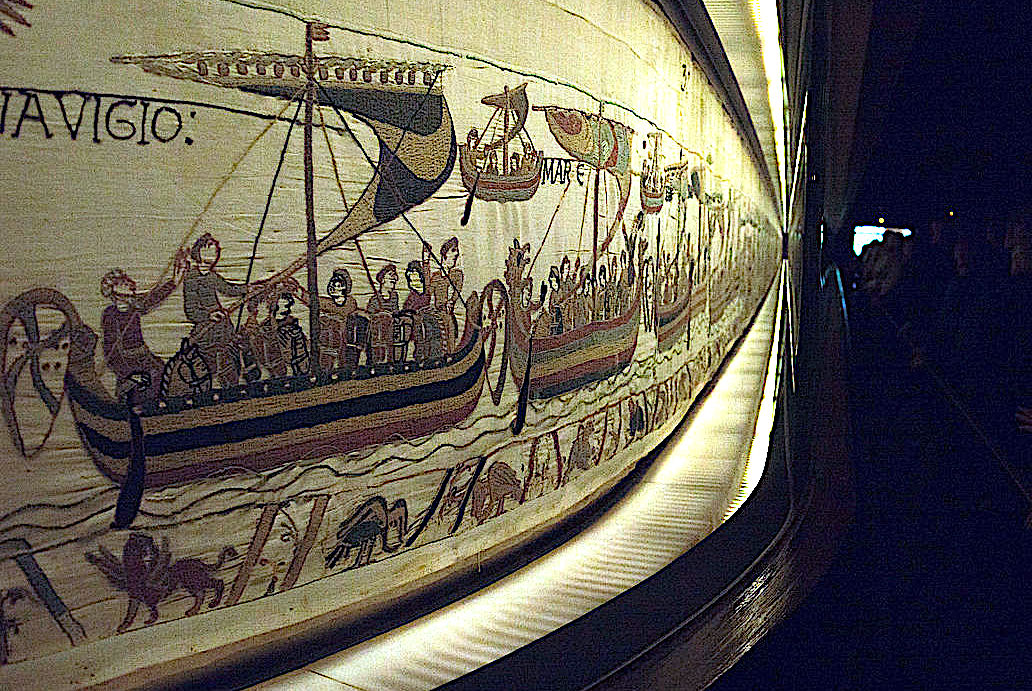A hand-tinted photographic replica of the renowned Bayeux Tapestry, measuring 70 meters long, has found its new home at the Bayeux Museum in France. The extraordinary acquisition, costing a mere £16,000, was part of the late Rolling Stones drummer Charlie Watts’s estate.
Dating back to 1872, the tapestry’s documentation was a daring endeavour by a photographer from the South Kensington Museum, now known as the Victoria and Albert Museum. It resulted in the creation of photographic reproductions of the iconic artwork. These images, captured on glass plates and meticulously hand-coloured, provided a vivid snapshot of the 1066 invasion of England by William the Conqueror and the Battle of Hastings. The painstaking process of creating these replicas, involving precise attention to detail and a deep understanding of the original artwork, underscores their historical and cultural significance.
Among the six photographic reproductions produced, one eventually found its way into the possession of Charlie Watts, the legendary Rolling Stones drummer who passed away in 2021. This invaluable piece of history has been entrusted to the Bayeux Museum, which will undoubtedly enrich the institution’s collection and deepen our understanding of the tapestry’s legacy.
Clémentine Paquier-Berthelot, a spokesperson for the museum, hailed the replica as a priceless artefact, emphasizing its role in tracking the tapestry’s deterioration over time. With only three known examples of this copy, its acquisition marks a monumental achievement for the museum and the preservation of cultural heritage.
Despite previous speculations about loaning the tapestry to Britain, French President Emmanuel Macron’s promise was met with scepticism, given the artwork’s fragile condition. Paquier-Berthelot reaffirmed that the tapestry would remain safeguarded from any potential harm within the museum’s confines.
As plans for the museum’s renovation take shape, including the construction of a new building dedicated to the tapestry’s conservation, anticipation mounts for its grand reopening in 2027. The museum’s commitment to conserving the tapestry, a testament to its cultural and historical significance, is reflected in these plans. With state and regional funding secured, the museum is poised to showcase these historic photographs alongside the tapestry, offering visitors a glimpse into the past and a deeper appreciation for this timeless masterpiece.
The Bayeux Tapestry, a UNESCO-listed world heritage object, is a testament to the enduring power of art and history. Its presence at the Bayeux Museum continues to draw crowds, captivating audiences with its intricate embroidery and rich narrative of medieval times.
The Bayeux Tapestry replica has come full circle, enriching the museum’s collection and preserving a cherished piece of our cultural heritage for generations to come.
The Bayeux Tapestry, a renowned artefact of medieval history, unravelled the epic tale of the Norman Conquest of England in 1066. Measuring nearly 70 meters in length, this embroidered cloth offers a vivid pictorial account of events leading up to and following the Battle of Hastings.
Commissioned shortly after the conquest, the tapestry is believed to have been crafted by skilled English artisans in the 11th century. Its origins are mysterious, with scholars debating whether it was created in England or France. However, it is commonly associated with Bishop Odo of Bayeux, half-brother of William the Conqueror, who may have played a role in its production.
Despite its name, the Bayeux Tapestry is not a tapestry but rather an embroidery, meticulously stitched on linen cloth with coloured wool threads. Its panels depict scenes of battle, feasting, and political intrigue, offering a rare glimpse into medieval life and warfare.
The tapestry has fascinated historians and art enthusiasts for centuries, serving as a valuable primary source for understanding the Norman Conquest and its events. Today, it is housed in the Bayeux Museum in Normandy, France, where it continues to captivate visitors worldwide with its rich historical narrative and exquisite craftsmanship.
Top Photo: Wikki Commons The Bayeux Tapestry in its museum. Author Supercarwaar

